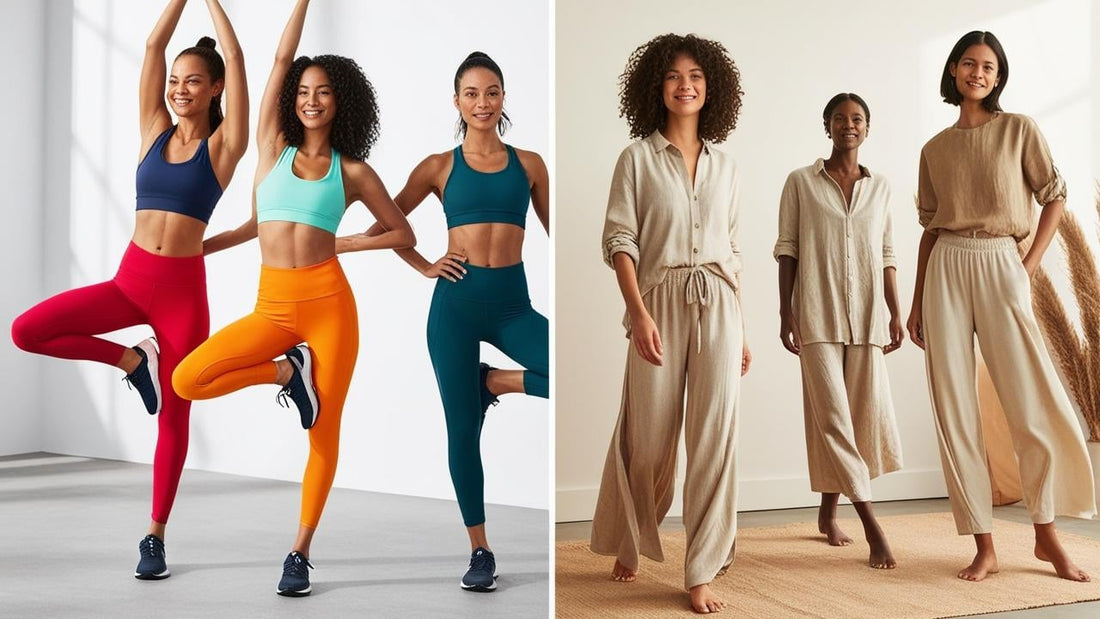
Natural vs. Synthetic Fibers: What Are Your Clothes Made Of?
Share
When you pick up a shirt or jacket, do you know what it’s made of? You’ve probably seen terms like rayon, cotton, microfiber, or viscose on clothing labels. But what do these words actually mean? And perhaps more importantly—are they natural, synthetic, or something in between?
Understanding your clothing at the fibre level is the first step to making informed, ethical, and environmentally sound choices. In this post, we're breaking down the most common fibres in modern fashion—from A to W—and explaining what they're made of, how they’re used, and what you should know about each one.
What’s the Difference Between Natural, Synthetic, and Semi-Synthetic Fibres?
Before we dive in, let’s set the stage:
- 🪴 Natural fibers: Derived from animals or plants. These include cotton, wool, hemp, and silk. They’re biodegradable, breathable, and often better for sensitive skin.
- 🧪 Synthetic fibers: Man-made, usually from petrochemicals. Polyester, nylon, and acrylic fall into this category. They’re durable, cheap, and often wrinkle-resistant—but also contribute to microplastic pollution.
- 🌿 Semi-synthetic fibers: Start as natural materials (often wood pulp or bamboo) but are chemically processed. Rayon, modal, and lyocell are good examples. Their eco-friendliness depends heavily on the manufacturing process.
Watch the full video here
The Ultimate Fabric Guide: A to W
We couldn’t find any fibres that start with “Z,” but we’ve got you covered from A to W. Here's the breakdown:
Acrylic
❌ Synthetic
Invented by DuPont in the 1940s, acrylic is made from acrylonitrile, a petrochemical. It’s designed to mimic wool and is commonly used in sweaters, scarves, and socks.
⚠️ Acrylic is one of the worst offenders for microplastic shedding—even more than polyester.
Alpaca
✅ Natural
Comes from the alpaca, a South American camelid known for its luxurious, warm fleece. Alpaca wool is prized for being softer, lighter, and warmer than sheep’s wool.
Bamboo
⚠️ Natural origin, but chemically processed
While bamboo grows quickly and without pesticides, bamboo fibre is usually turned into rayon using toxic solvents like carbon disulfide. Bamboo rayon may be marketed as eco-friendly, but it often involves significant chemical processing.
Camel Hair
✅ Natural
Harvested from Bactrian camels, usually by combing during their natural moulting season. Naturally warm and soft, with a desirable golden-brown colour that often goes undyed.
Cashmere
✅ Natural
Sourced from the undercoat of Pashmina or Cashmere goats in India, Nepal, and Mongolia. Cashmere is known for its incredible softness and insulation, often used in high quality scarves and sweaters.
Cotton
✅ Natural
Cotton comes from a small boil and is the most popular natural fibre around. Check out our full blog post here
Elastane (Spandex)
❌ Synthetic
Known in Europe as elastane and in the U.S. as spandex. It's prized for its stretch. Often found blended into jeans, leggings, swimwear, and most commonly, activewear.
Hemp
✅ Natural
Made from the Cannabis sativa plant. Strong, breathable, and antibacterial. Hemp was illegal to grow in the U.S. until 2019 but is now making a comeback in sustainable fashion. Bonus: Hemp requires little water and no pesticides—making it a sustainability superstar.
Jute
✅ Natural
Derived from the stalk of the jute plant, it has a coarse texture and is typically used in bags, sweaters, and rugs. Jute production is carbon-neutral, and it's fully biodegradable.
Lamb’s Wool
✅ Natural
Comes from a sheep’s first shearing, typically around seven months old. Softer than regular wool and commonly found in sweaters, suits, and knitwear.
Linen
✅ Natural
Made from the flax plant. One of humanity’s oldest known textiles, dating back thousands of years. Breathable, antimicrobial, and biodegradable. Learn more here!
Lyocell (Tencel)
⚠️ Semi-synthetic
Made from eucalyptus wood pulp in a closed-loop process using non-toxic amine oxide. Biodegradable and gentler on the environment than other rayons like viscose. Common in underwear, athleisure, and soft knits.
Leather
✅ Natural
Made from the hide of animals, usually cows, but also deer, snakes, and crocodiles. Durable and long-lasting. If properly cared for, leather can last decades.
Lycra
❌ Synthetic
A trademark name for spandex, developed by DuPont. Used interchangeably with elastane/spandex.
Microfiber
❌ Synthetic
A super-fine form of polyester, often used in cleaning cloths, fast fashion, and athletic wear. Releases large amounts of microplastics into water systems with each wash.
Modal
⚠️ Semi-synthetic
A form of rayon made from beech trees, modal is softer and more durable than traditional rayon. Common in underwear, t-shirts, and loungewear.
Mohair
✅ Natural
Comes from the Angora goat (not to be confused with angora rabbit). Lighter and shinier than wool, mohair is used in scarves, coats, and summer-weight suits.
Nylon
❌ Synthetic
Developed in the 1930s by DuPont and originally used for women’s stockings. Nylon is durable and abrasion-resistant, making it ideal for outerwear, luggage, and even toothbrush bristles.
Polyester
❌ Synthetic
Made from polyethylene terephthalate (PET)—the same plastic as soda bottles. Found in everything from t-shirts to upholstery. Cheap to produce, but contributes significantly to plastic pollution. Many brands now offer recycled polyester, made from post-consumer plastic bottles.
Rayon
⚠️ Semi-synthetic
An umbrella term for fibres made from dissolved cellulose (wood pulp, bamboo, etc.). Includes viscose, modal, and lyocell. It’s biodegradable but manufacturing can involve harsh chemicals like carbon disulfide.
Silk
✅ Natural
Comes from mulberry silkworms. They spin cocoons made of silk fibres, which are harvested for textile use. Luxurious and soft. Found in everything from pajamas to ties to blends with wool.
Spandex
❌ Synthetic
Known for its extreme elasticity—can stretch 5x its original length. Developed in the 1950s, spandex became iconic during the 1970s aerobics craze. Still essential in athleticwear, swimwear, shapewear, and denim.
Suede
✅ Natural
A type of leather with the underside facing out, giving it a soft, napped finish. Common in shoes, jackets, and bags.
Ultrasuede
❌ Synthetic
A branded microfiber with added polyurethane. Meant to mimic the look and feel of real suede. Common in car interiors, handbags, and fashion accessories.
Vegan Leather
❌ Synthetic
Usually made from PVC or polyurethane, despite the ethical-sounding name. There are emerging plant-based alternatives (like mushroom leather or apple leather), but 99.99% of vegan leather today is plastic. We rant about that here.
Wool
✅ Natural
Usually refers to sheep’s hair, unless specified otherwise (like alpaca or mohair). One of the most versatile fibres—great for warmth, breathability, and durability. Learn more about merino wool here.
Why Does it Matter What Your Clothes Are Made of?
Knowing your fabrics can help you:
- 🧵 Shop smarter: Avoid greenwashing and make purchases aligned with your values.
- 🌎 Reduce environmental impact: Opt for biodegradable, low-impact fibres.
- 💸 Get more value: Understand durability, care, and lifespan before buying.
- 💡 Educate others: The more people understand fibre types, the better choices we can make together.
Final Thoughts
There you have it—the most common clothing fibres, from A to W. Whether you’re new to the world of sustainable fashion or just curious about what goes into your clothes, understanding fibres is a foundational step.
If you found this helpful, please share it with a friend and don't forget, we have all your natural goods made with integrity right here at Textile Apparel.
Thanks for reading!
